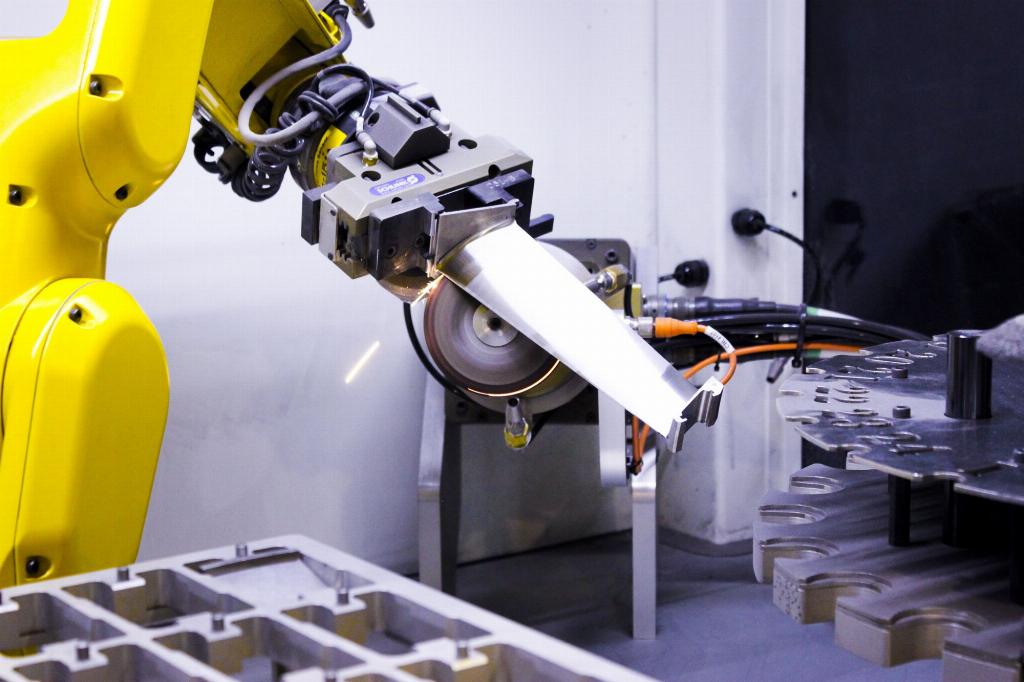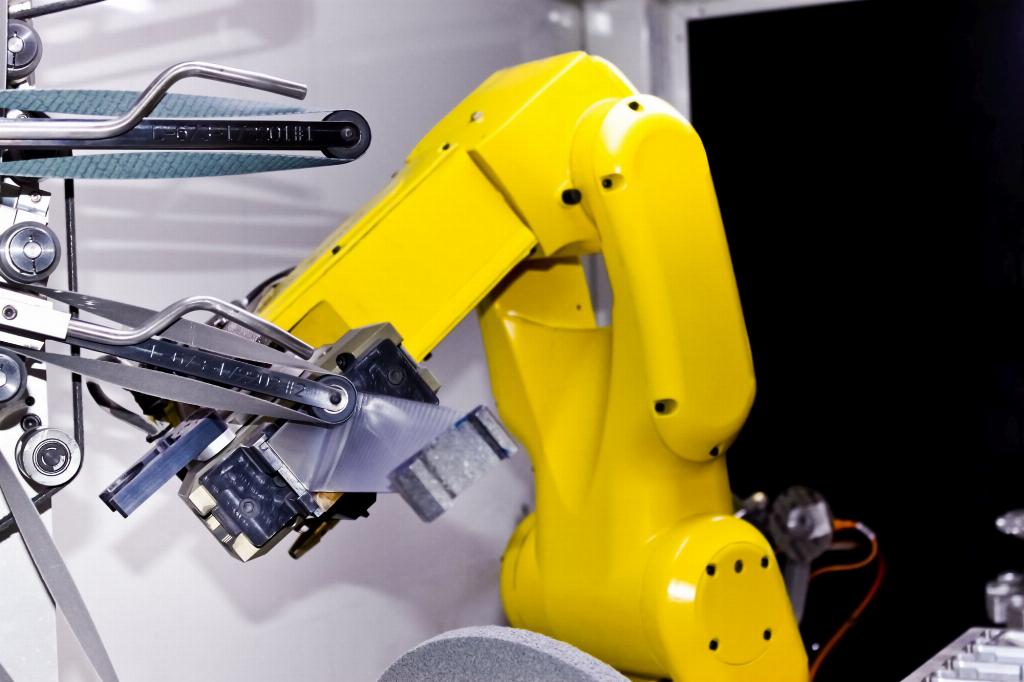A celebration of automation

Employed by some of the world’s leading aero-engine manufacturers, AV&R has recently celebrated 25 years of robotic visual inspection. James Careless reports.
Employed by some of the world’s leading aero-engine manufacturers, AV&R has recently celebrated 25 years of robotic visual inspection. James Careless reports.
In 1994, a small robotics systems company that was eventually named AV&R was founded in Montreal. It specialised in visual inspection and surface finishing for a range of precision manufactured products, including high-pressure jet engine compressor blades. Fast forward to today and AV&R has grown so much that its inspection and surfacing robots have become necessary tools employed by the world’s jet engine manufacturers.
“Currently, more than 80% of the high-pressure compressor blades manufactured by OEMs worldwide are profiled by AV&R,” says Jean-François Dupont, AV&R’s CEO. These OEMs include GE Aviation, Pratt & Whitney, Rolls-Royce, and Safran.
AV&R’s rise to prominence in aerospace visual inspection wasn’t intentional. When the company began, they pursued multiple machine vision projects in different markets such as automotive, lighting, and optical lenses using a mix of commercially available equipment and algorithms.
Then the company happened upon the aerospace industry and its mix of highly complex parts that demanded precision visual inspection and surfacing consistency to the highest degree. Impressed by the opportunities aerospace offered for a robotic systems company such as AV&R, “we decided to focus on this niche market and develop the technology needed,” says Philippe Masson, AV&R’s strategic partnership manager.
This was no small challenge: “Visual surface inspection is a very difficult process because most of the parts are good and the same focus is needed for good and bad parts,” states Masson. “The technology we developed is aiming at helping visual inspectors of surface defects improving the quality of their work by removing automatically good parts and reporting relevant indication to be reviewed.”
The finer details
Designed to inspect and finish compressor blades ranging in size from under 200mm to 800mm, AV&R’s automated visual inspection/surfacing systems are intended to be extremely accurate and highly reliable; which is why they have been adopted by major jet engine OEMs. To meet these standards, “our robotic system is based on well-known and documented machine vision techniques, such as photometric stereo that we use with algorithms developed internally to detect anomalies on the surface,” says Masson. “Anomalies are then filtered and the relevant ones are reported to the inspector with information such as size, zone and contrast to facilitate the final decision.”

Currently, AV&R’s visual inspection and surfacing robots are mainly on single airfoil blades. Size doesn’t matter: “Our system can inspect blades varying from a very small compressor blade up to a large fan blade,” Masson explains. “It can also inspect complex shapes and features usually found on turbine blades.”
AV&R’s robotics systems are also flexible: “The technology is usable on metallic surfaces ranging from matte finish to reflective surfaces,” states Masson. “We are also focusing on new-make parts in the different production steps from cast or forged surfaces up to the final part with machined and coated surfaces.”
A trio of robotics systems
AV&R makes three blade inspection/surfacing ‘booths’; each of which use robotic arms and tools inside, and are controlled by software that can be accessed via attached external workstations. They are the BF-X 200-i, BF-X 200-c, and the BF-X 800. The term ‘BF-X' stands for ‘Blade Finishing Expert'. All booths are built with large viewing windows on all sides, so that the operators can see what’s happening throughout the automated process.
The BF-X system uses a robotic arm to first lift the blade in question up to a visual inspection instrument to compare its profile to the desired baseline. The arm then takes the blade down to spinning surfacing and polishing wheels to shape it to the right shape and smoothness, and then back to the visual inspection area to ensure compliance, or execute further work. No human handling is required, while human errors, material wastage, and injuries are avoided.
To be exact, AV&R’s robotics systems are capable of performing four distinct functions: profiling and blending the blades down to a ±37.5µm tolerance (±1.5 thousandth of an inch or 0.04mil); deburring the blades to achieve the profiled shape while removing excess metal and imperfections; polishing the deburred blades with average material removal between 25 and 125µm (between 1 and 5mils), with a consistency of ±15µm (±0.6mil) from one part to another; visually inspecting the blades at the outset of the job, and then at the end to ensure that the desired changes have been accomplished.

The three booths can be used in range of functions. For instance, the BF-X 200-i can be configured to either profile or deburr airfoil blades under 200mm in size following visual inspection. The BF-X 200-c is capable of doing any two of the following three processes for airfoil blades under 200mm; namely profiling, blending, and polishing.
Meanwhile, the BF-X 800 handles blades between 500mm and 800mm in size, and can perform the full range of functions such as profiling, blending, deburring, and polishing.
One interesting feature of all AV&R visual inspection/surfacing robotic systems is that they are designed to be operated by technicians without programming experience. This “humanisation of robotics”, as AV&R terms it, opens up robotics-based systems to a wider range of employees and users. It also helps to keep human resources costs down.
Onwards and upwards
Becoming an industry leader is a major accomplishment after 25 years. But AV&R isn’t resting on its laurels. Instead, the company is investing heavily in R&D to develop new products and new possibilities.
“One of the major R&D projects we are currently doing is a Consortium for Research and Innovation in Aerospace in Québec (CRIAQ) project aiming at inspecting and repairing critical MRO parts with Rolls-Royce Canada,” says Masson; in league with the Canadian government’s Industrial Research Assistance Program and National Research Council, plus the Polytechnique Montréal and Laval University. “This project is developing the capability to detect defects on a specific surface, measure the defects in 3D and repair the defects automatically using a robot with abrasives.”
In addition, AV&R is “developing the capabilities to inspect complex mirror surfaces and composites such as the latest versions of fan blades and extending our technology to fluorescent penetrant inspection,” Masson concludes. “We are also looking at expanding this technology to new markets.”
All told, robotics have been good to this Canadian visual inspection and surfacing company, allowing it to achieve niche market dominance today and positioning it well for the future. For AV&R and its employees, the future looks very bright indeed.













